- 2025 water use expected to be the lowest since 1949.
- State population quadrupled while overall use declined.
- Conservation and innovation credited for long-term success.
- Federal and Basin-state partnerships raised Lake Mead levels.
- Future plans call for continued cuts and new water sources.
Friday, November 7, 2025 — Yesterday, the Colorado River Board of California announced that the state’s water use from the Colorado River is projected to reach its lowest point since 1949. The achievement reflects over seven decades of steady progress toward efficiency and sustainability, proving that population and economic growth do not have to come at the expense of water resources.
announced that the state’s water use from the Colorado River is projected to reach its lowest point since 1949. The achievement reflects over seven decades of steady progress toward efficiency and sustainability, proving that population and economic growth do not have to come at the expense of water resources.
JB Hamby, Chairman of the Colorado River Board of California and the state’s chief negotiator in Colorado River discussions, said the milestone shows what cooperation can achieve. “California is showing what can be done through collaboration and a commitment to action,” Hamby said . “We’ve proven that net reductions do not preclude growth. The sustainability of the Colorado River is a shared responsibility.”
. “We’ve proven that net reductions do not preclude growth. The sustainability of the Colorado River is a shared responsibility.”
A Growing Population, a Shrinking Water Footprint.
California’s population has increased nearly fourfold since the 1940s, from about 10 million residents to almost 40 million today. During that time, its economy grew into a $4-trillion global powerhouse—now the fifth largest in the world. Despite this explosive growth, the state’s Colorado River use is expected to drop to 3.76 million acre-feet in 2025, the lowest in more than seventy years.
This long-term decline in water use stems from substantial investments by California’s water agencies, farmers, cities, and tribes. Efforts have included billions of dollars spent on conservation programs, storage and groundwater recovery projects, and the expansion of local water supplies through recycling and seawater desalination—the largest of its kind in the nation.
The Quantification Settlement Agreement and Urban Conservation.
A cornerstone of California’s water strategy has been the Quantification Settlement Agreement (QSA) of 2003. This landmark agreement created the largest agricultural-to-urban water transfer in U.S. history, permanently cutting the state’s Colorado River use by about 800,000 acre-feet that year. Since then, Southern California farms have reduced water use by more than 15 percent while maintaining roughly $3 billion in annual productivity. Urban agencies have also cut their reliance on imported water by half, even as they serve millions of additional residents.
Jessica Neuwerth, Executive Director of the Colorado River Board, credited teamwork and accountability for the results. “California’s progress demonstrates what’s possible when states lead with cooperation, innovation, and accountability,” she said. “This milestone reflects years of dedication by all CRB agencies, and it strengthens our resolve to continue leading with action and partnership in the work ahead.”
Collaborative Efforts Across the Basin.
The reduction in California’s use has not occurred in isolation. Over the past twenty years, the state has joined Arizona and Nevada in collective conservation efforts that have raised the elevation of Lake Mead by nearly 160 feet. From 2020 through 2026, aided by cooperation with the U.S. Department of the Interior, the Lower Basin states are projected to reduce water use by 7.5 million acre-feet in total.
Under the Lower Basin Plan, California has also pledged to further reduce its annual use by 440,000 acre-feet as part of the region’s collective effort to stabilize the river’s operation. Hamby noted that maintaining these reductions will require continued innovation: “Sustaining this lower water use for the long-term will take additional investments in new local water supplies and water-efficiency.”
Looking Ahead: The Next Chapter for the Basin.
With negotiations already underway for new operating rules to begin in 2027, California’s example offers a possible blueprint for the future. The state’s experience demonstrates that reductions in water use are compatible with population and economic growth—if supported by long-term planning and cooperation among Basin partners.
As Hamby concluded, “We know it is possible for cities and farms across the Basin in all seven states to reduce their use of Colorado River water just as California has without impacting their opportunities to grow and thrive. We know there is a way; what we need is the will to act.”
About the Colorado River Board of California.
Established 88 years ago, the Colorado River Board of California represents the state and its agencies in all discussions concerning the management of the Colorado River with Basin states, federal and local governments, and Mexico. Its mission is to protect California’s interests and rights in the water and power resources of the Colorado River system.
Image: Blythe, California, and Colorado River, seen from the air . This is the border between California (on left) and Arizona (on right). Created by Northwalker. Licensed under the Creative Commons CC0 1.0 Universal Public Domain Dedication.
. This is the border between California (on left) and Arizona (on right). Created by Northwalker. Licensed under the Creative Commons CC0 1.0 Universal Public Domain Dedication.
FAQ
Q: How much water is California projected to use in 2025?
A: The state’s Colorado River use is projected to fall to 3.76 million acre-feet, the lowest since 1949.
Q: What is the Quantification Settlement Agreement (QSA)?
A: The QSA, signed in 2003, permanently reduced California’s Colorado River use by about 800,000 acre-feet through agricultural-to-urban water transfers and conservation programs.
Q: How has California achieved these reductions while growing?
A: Through investments in recycling, desalination, groundwater recovery, and conservation efforts across both agricultural and urban sectors.
Q: What role has collaboration played?
A: California’s progress has depended on partnerships with Arizona, Nevada, and the federal government to stabilize Lake Mead and implement long-term conservation plans.
Q: Who provided the information for this report?
A: This article is based on information from the Colorado River Board of California, with credit to the Western Governors’ Association.





